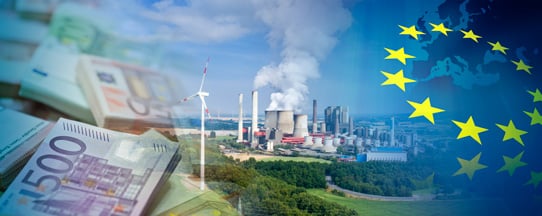
EU Adopts Revised Guidelines on State Aid for Climate, Environmental Protection and Energy
In Short
The Development: The European Commission ("Commission") adopted new Guidelines on State Aid for Climate, Environmental Protection and Energy ("CEEAG") on 27 January 2022. The CEEAG revise criteria that the Commission will now apply to determine whether EU Member State financing to private companies in the field of climate, environmental protection, and energy is compatible with EU law.
Background: The CEEAG replace the Guidelines on State Aid for Environmental Protection and Energy 2014-2020 ("EEAG"). The CEEAG align the State aid rules with the European Green Deal, which details the EU strategy for climate and environmental-related challenges and targets no net emissions of greenhouse gas in 2050.
Looking Ahead: The Commission's intent in updating the CEEAG is to facilitate State aid measures supporting technologies and investments that contribute to the EU's climate policy objectives while "phasing out support to fossil fuels." Environmental and energy projects already account for a majority of State aid spending in the EU, and businesses seeking public financing need to ensure that environmental and energy projects conform to the new rules.
Background
EU rules prohibit "State aid," unless the Commission authorizes the aid as compatible with the EU Treaties. State aid is a Member State funding measure imputable to the State and financed through State resources that benefits an undertaking (i.e., an entity engaged in an economic activity), and that provides the beneficiary with an advantage on a selective basis, distorts or threatens to distort competition, and affects trade among EU Member States.
EU rules recognize that, in some circumstances, government support is necessary for a well-functioning and equitable economy. In particular, the Commission may authorize aid as compatible with the EU Treaties when its positive effects outweigh the negative impact on competition. EU Member States must notify new State aid measures to the Commission and measures can only take effect if the Commission approves, unless covered by a block exemption regulation.
The CEEAG provide guidance on how the Commission will evaluate the compatibility of environmental, climate protection, and energy aid measures which are subject to the notification requirement. The CEEAG work in tandem with the General Block Exemption Regulation ("GBER"), which provides for certain compatibility conditions on the basis of which a Member State can implement specific categories of State aid without prior notification to the Commission. The Commission also is revising relevant sections of the GBER to address the CEEAG and to facilitate aid measures supporting its green transition policies.
Wide Range of Aid Measures Covered
The CEEAG are extensive and cover many new categories of State aid measures relevant for the European Green Deal, including the reduction and removal of greenhouse gas emissions, building energy performance, clean mobility, resource efficiency, transition toward a "circular economy," prevention or reduction of pollution other than from greenhouse gases, remediation of environmental damage and biodiversity, reductions from electricity levies for energy-intensive users, and closure of power plants using coal, peat, or oil shale.
The CEEAG still exclude nuclear energy, meaning that the Commission will continue to evaluate State aid measures involving nuclear energy under the general State aid rules. A useful precedent is the Commission's 2014 decision in the Hinkley Point C case (later affirmed in the EU Courts) in which the Commission concluded that EU State aid rules allowed for measures supporting the construction and operation of a new nuclear power plant.
The CEEAG also do not cover State aid for research, development, and innovation ("RDI"). State aid involving RDI is subject to separate guidelines, the RDI Framework, which the Commission is revising.
General Compatibility Criteria
The first part of the CEEAG describes the compatibility criteria that the Commission applies generally to the various categories of environmental protection (including climate protection) and energy aid measures covered. The Commission will verify that the aid satisfies two conditions, one positive and one negative.
The positive condition requires that the aid must facilitate the development of an economic activity. The Commission will analyze whether the notified aid:
- Benefits society and contributes to the successful implementation of EU climate, environmental, and energy policy;
- Has an incentive effect by inducing the beneficiary to change its behavior or engage in economic activities in accordance with EU policy that may not have occurred absent the aid; and
- Does not breach EU law.
The negative condition requires that the aid must not adversely affect trading conditions to an extent contrary to the common interest. In determining whether this condition is met, the Commission will examine whether the notified aid:
- Is necessary, i.e., State aid is required to achieve the environmental objective because the market will fail to achieve the objective on its own;
- Is appropriate, i.e., there is no other policy or aid instruments that will obtain the same result with less impact on trade and competition;
- Is transparent, i.e., the Member State must publish the full text of the approved aid measure and information on each individual aid award exceeding EUR 100,000;
- Is proportionate, i.e., State aid is limited to the minimum amount necessary to achieve the project or activity. In principle, aid is proportionate if it corresponds to the net extra cost ("funding gap") necessary to meet the objective of the aid measure compared to the counterfactual scenario in the absence of aid. However, a detailed assessment of the funding gap is not required if the State determines the amount of aid through a competitive bidding process. The CEEAG assume competitive bidding provides a reliable estimate of the minimum aid that potential beneficiaries require.
The CEEAG increase the emphasis on the role of competitive bidding which, for example, it advises States to use as the default mechanism for granting aid for the reduction of greenhouse gas emissions and for clean mobility. In those cases, the CEEAG allow for aid amounts up to 100% of the funding gap.
If the State does not grant the aid through a competitive bidding process, the Commission determines the proportionality of the aid based on the funding gap analysis or, in circumstances where it is difficult to fully identify the benefits and costs to the beneficiary, based on a maximum amount calculated as a percentage of the eligible costs (the maximum "aid intensity"); and
- Does not unduly affect competition and trade, for example, by raising barriers to the entry of more efficient or innovative potential competitors or by strengthening or maintaining substantial market power of the beneficiary. Distortive effects can be particularly important when a State grants aid to projects that provide a limited transitory benefit, but that lock out cleaner technologies for a longer term.
As a final step, the Commission balances any negative effects of the aid measure on competition and trade against its positive effects on the supported economic activities, including contribution to the EU's environmental protection and energy policy objectives. Only those State aid measures that have positive effects that outweigh the negative effects will pass muster with the Commission.
In that balancing exercise, the Commission pays particular attention to the "do no significant harm" principle set forth in the EU Taxonomy Regulation, which is becoming a general criterion in EU State aid law. Under that principle, the Commission must consider whether economic activity significantly harms the EU's objectives with respect to climate change, sustainability, waste prevention, recycling, pollution prevention and control, and biodiversity, among other factors. According to the CEEAG, the Commission is unlikely to conclude that aid supporting fossil fuels has a net positive effect. The same applies to measures involving new investments in natural gas, unless the Member State demonstrates that the aid does not lock the State into natural gas technology.
Specific Compatibility Criteria
The second technical part of the CEEAG delineates specific compatibility criteria that apply to the 13 categories of aid that the CEEAG cover. As noted above, those categories cover a wide range of environmental and energy topics. One of the main highlights is the new section dedicated to aid for the reduction and removal of greenhouse gas emissions. The CEEAG broadly define that category of aid to encompass financial support to all technologies that can contribute to the reduction of greenhouse gas emissions, including aid for all types of renewable energy, the production of low-carbon energy (such as hydrogen), energy efficiency including high-efficiency cogeneration, carbon capture, demand response and energy storage, the reduction or avoidance of emissions resulting from industrial processes, and electrification.
The CEEAG require Member States to conduct a public consultation on the competitive impact and proportionality of large aid measures notified under this category of aid. Public consultations are intended to increase stakeholder participation in the design of those measures, enhancing the inclusiveness and transparency of the process. In addition, aid for reducing greenhouse gas emissions should in general be granted through a competitive bidding process.
Aid for the reduction of greenhouse gas emissions can take various forms, including upfront grants and "contracts for difference," or CfD, i.e., contracts compensating the beneficiary for the difference between a fixed "strike" price and a market price to ensure stable and predictable revenue streams. Such contracts could involve a market price linked to the EU Emissions Trading System, or ETS, thereby becoming "carbon contracts for difference," or CCfD.
The CEEAG also state that aid for the reduction of greenhouse gas emissions should not lock in certain technologies or displace investments into cleaner alternatives. Therefore, the CEEAG's rules instruct the Commission to verify that the aid measure does not stimulate or prolong the consumption of fossil-based fuels and energy, consistent with the EU's stated policy goals. According to the CEEAG, measures involving new investments in what it deems to be the "most polluting fossil fuels such as coal, diesel, lignite, oil, peat and oil shale" will not be considered to have any positive environmental effects, given the incompatibility of these fuels with the EU's climate targets.
Natural gas, according to the Commission, is a "special case," acting as a bridge on the path to more renewables. The CEEAG permit the Commission to approve measures involving new investments in natural gas only if the Member State demonstrates that the investments contribute to achieving the EU 2030 and 2050 climate targets and there is no lock-in effect. For example, this demonstration may be based on binding commitments by the beneficiary to replace natural gas with renewable energy or to close the plant on a timeline consistent with the EU climate targets.
Three Key Takeaways
- To achieve the EU's Green Deal policy objectives, Member States will have to make massive investments toward environmental and energy projects. The CEEAG provide Member States and aid recipients guidance about how to structure and analyze publicly financed projects to obtain Commission approval under the EU State aid rules.
- The CEEAG cover a wide range of areas that Member States can support, from the reduction and removal of greenhouse gas emissions to the energy and environmental performance of buildings or clean mobility.
- The CEEAG's rules are technical and complex. Companies that plan ahead and tailor projects and funding requests to be consistent with the CEEAG are likely to come out ahead both when Member States make decisions about which projects to fund and in Commission review





